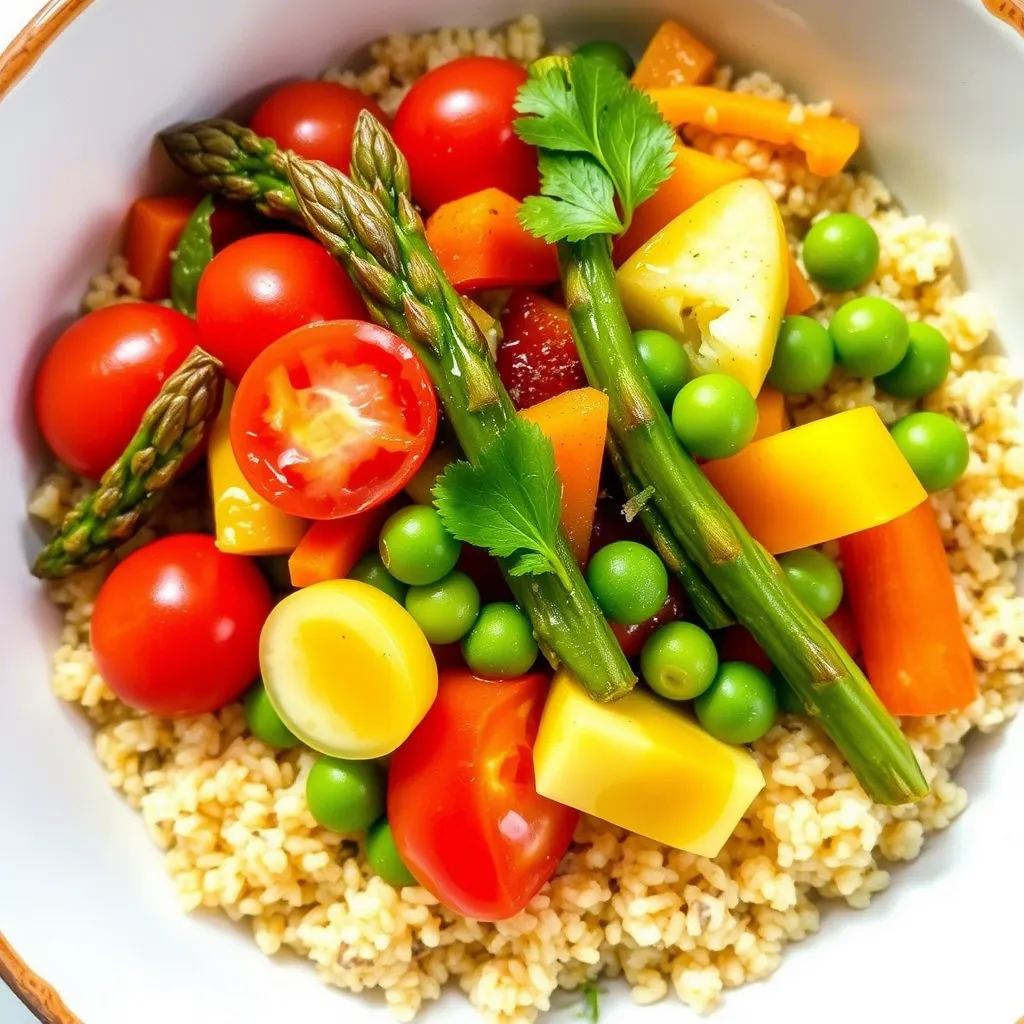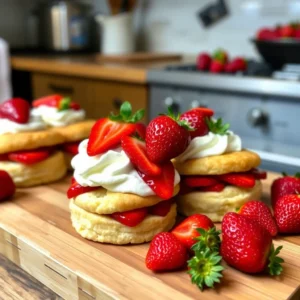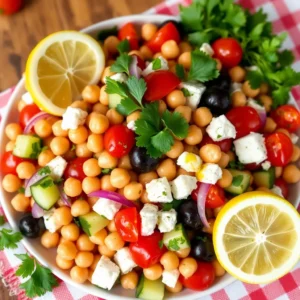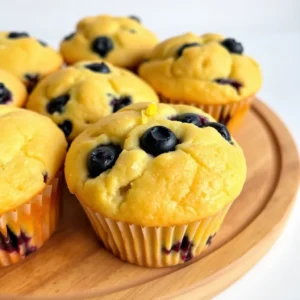Why You’ll Love This Spring Vegetable Quinoa Bowl
Let’s face it, dear friends – we’ve all been there. Standing in the kitchen at 6:30 PM on a Tuesday, staring into the fridge with the same tired chicken and potatoes that have been lurking since last week. Sound familiar? I know my own kids would rather eat cereal for dinner than deal with another “mystery meat” casserole. That’s why this spring vegetable quinoa bowl has become my kitchen savior.
This vibrant dish is like a breath of fresh air on a plate. Imagine tender asparagus spears, plump peas, and crisp radishes dancing with fluffy quinoa, all tied together by a zesty lemon vinaigrette that wakes up your taste buds. It’s not just food – it’s a flavor party! And the best part? It’s ready in under an hour, making it perfect for those days when you’re juggling soccer practices, work deadlines, and trying to remember if you paid the electric bill.
What makes this recipe truly special is how it manages to be both indulgent and virtuous. The protein-rich quinoa keeps you full until your next meal (or until midnight snack time), while the fresh spring vegetables add a rainbow of nutrients that make you feel like you’re doing something good for yourself. I mean, who knew a salad could be so satisfying? My husband used to say he’d never eat a salad for dinner, but now he actually asks if we can have leftovers!
And let’s talk about versatility for a second. One day I might serve it with grilled chicken for extra protein, another day it’s just the veggies and quinoa. Want to make it heartier? Add some chickpeas or black beans. Feeling fancy? Top it with some crumbled feta or goat cheese. This bowl adapts to whatever mood you’re in, which is exactly what busy home cooks need.
Oh, and don’t even get me started on the colors! This dish looks so beautiful that I sometimes forget to take a picture before everyone devours it. But when I do manage to snap a photo, my kids ask, “Is that going on Instagram?” (Spoiler alert: yes, it is!) It’s the kind of meal that feels special enough for company but simple enough for a lazy weeknight.
Now, if you’ll excuse me, I hear the timer going off in my kitchen. Time to check on my quinoa. But first, let me share how this recipe came to be…
The Story Behind This Spring Vegetable Quinoa Bowl
Now, let me take you back to the day this recipe was born. It was one of those perfect spring mornings when the sun was just beginning to peek through the trees, and the air carried that fresh, clean scent of blooming flowers. I had just finished a long walk around the neighborhood, feeling energized and ready for the day ahead. But as I stepped into my kitchen, I was greeted by the same old routine: what’s for lunch? That’s when it hit me – why not celebrate the season with a dish that truly showcases spring’s bounty?
You see, grain bowls have become something of a kitchen staple in recent years, and for good reason. They’re quick, they’re nutritious, and they offer endless possibilities for customization. But I wanted to create something special – a bowl that would capture the essence of spring in every bite. I started with quinoa, because not only is it a complete protein, but it also has this lovely texture that pairs perfectly with fresh vegetables.
As I rummaged through my fridge, I found some beautiful asparagus from the local farmers’ market, still crisp and vibrant green. A bag of frozen peas (I know, I know – but sometimes convenience is key) caught my eye, along with a few sprigs of fresh dill that were begging to be used. I thought about adding some color with radishes or maybe some snap peas, and before I knew it, I had a full rainbow of spring produce right there on my cutting board.
The vinaigrette was another moment of inspiration. I’ve always been a fan of lemon-based dressings, and this time I decided to add a bit of Dijon mustard for depth and some honey for balance. It was like a little symphony of flavors, each ingredient playing its part to create something greater than the sum of its parts. And honestly? The first spoonful made me want to do a happy dance in my kitchen.
But here’s what really makes this recipe special – it tells a story. Every time I make it, I’m reminded of that spring morning in my kitchen, of the joy of discovering new combinations, and of the satisfaction that comes from creating something nourishing and delicious. My kids now ask for it at least once a week, and I love how it brings us all together around the table. There’s something magical about sharing food that celebrates the season, don’t you think?
And if you’ll indulge me for a moment, I’d like to share a tip I picked up from one of my favorite cooking blogs – Incredible 30-Minute Vegetable Soup . While their soup focuses more on hearty winter vegetables, their approach to letting flavors develop over time inspired me to experiment with my own recipes. It’s amazing how such simple principles can lead to such wonderful results.
Ingredients
Let me share with you the delightful collection of ingredients that come together to create this Spring Vegetable Quinoa Bowl. The beauty of this recipe lies in its simplicity and the vibrant colors it brings to your plate. Here’s what you’ll need:
Main Ingredients
- Quinoa : This ancient grain is a powerhouse of nutrition, packed with protein, fiber, and essential amino acids. It serves as the perfect base for our bowl, providing a light yet satisfying texture. I recommend using white quinoa for a fluffy result, but you can also use red or tri-color quinoa for a pop of color.
- Spring Vegetables : We’re celebrating the season with fresh produce! Asparagus adds a lovely crunch, while peas contribute sweetness and a vibrant green hue. Radishes bring a peppery kick, and snap peas add a refreshing snap. You can also include other spring vegetables like carrots or zucchini for variety.
- Mixed Greens : A bed of mixed greens adds volume and a fresh, slightly bitter note that balances out the other flavors. Choose a mix of baby spinach, arugula, and kale for a nice textural contrast.
- Herbs : Fresh herbs elevate any dish, and here they add brightness and aroma. Dill, parsley, and chives work beautifully together, offering different layers of flavor. If you’re short on time, you can use a combination of fresh and dried herbs, but nothing beats the freshness!
- Olive Oil : A high-quality olive oil is essential for drizzling over the vegetables and mixing into the vinaigrette. It not only enhances the flavors but also helps to bind everything together.
- Lemon Juice : Freshly squeezed lemon juice is a game-changer in this recipe. It adds a zesty tang that brightens up the entire bowl. Don’t skip this step – the acidity is what ties all the flavors together.
- Seasonings : Simple seasonings like salt, black pepper, and a pinch of cayenne pepper (optional) will enhance the natural flavors of the ingredients. For an extra layer of depth, consider adding a bit of garlic powder or onion powder.
- Optional Add-Ins : To make this bowl heartier, you can add some grilled chicken, tofu, or chickpeas for additional protein. For a creamy element, try topping it with a dollop of Greek yogurt or a sprinkle of feta cheese.
Substitutions and Variations
While I’ve given you the core ingredients, feel free to personalize this bowl to suit your taste and dietary needs:
- Gluten-Free Option : Ensure that your quinoa and any added proteins are gluten-free. Most quinoa is naturally gluten-free, but always check the packaging if you have a sensitivity.
- Vegan Version : Skip the optional dairy toppings and choose a vegan protein source like tempeh or edamame. Use a plant-based yogurt instead of Greek yogurt for a creamy finish.
- Low-Carb Adaptation : Replace the quinoa with cauliflower rice for a lower-carb alternative. This keeps the bowl light while still providing a satisfying base.
- Protein Boost : If you’re looking to increase the protein content, add grilled shrimp, baked chicken, or a fried egg on top. These additions will transform the bowl into a more substantial meal.
- Dressing Variations : While the lemon vinaigrette is my favorite, you can experiment with other dressings like balsamic glaze, tahini, or a simple olive oil and vinegar dressing. Each variation offers a unique twist on the classic bowl.
For those who love a good story behind their food, I highly recommend checking out Incredible 30-Minute Vegetable Soup . While it’s a soup recipe, it shares similar principles of using seasonal vegetables to create something nourishing and delicious.
Now that we’ve covered the ingredients, let’s move on to how to bring this colorful bowl to life in your kitchen!
Additional Tips
Now that you’ve got the basics down, let’s dive into some extra tips to help you make the most of your Spring Vegetable Quinoa Bowl. Cooking is all about creativity and personalization, so don’t be afraid to experiment and find what works best for you and your family.
Perfecting Your Quinoa
First things first: quinoa can be a bit finicky if you’re not used to it. The key to perfect quinoa lies in the rinsing process. Before cooking, give it a good rinse under cold water to remove the saponins – natural compounds that can leave a bitter taste. I like to use a fine-mesh strainer for this, giving it a gentle shake until the water runs clear.
When it comes to cooking ratios, I usually go with 1 cup of quinoa to 2 cups of liquid (water or broth). Bring it to a boil, then reduce the heat to low, cover, and let it simmer for about 15 minutes. Once done, fluff it with a fork to separate the grains. If you’re feeling fancy, you can toast the quinoa in a dry pan for a minute or two before adding the liquid – it gives it a lovely nutty flavor!
Vegetable Preparation Made Easy
Now let’s talk about those spring vegetables. Fresh asparagus is a star ingredient here, but sometimes we’re faced with the challenge of cutting it just right. Here’s my trick: snap off the woody ends by holding one end and bending the spear until it breaks naturally. This ensures you get rid of the tough part without measuring.
For peas, whether fresh or frozen, I always recommend using a colander to drain them after cooking. They tend to release a lot of moisture, and excess water can make your bowl soggy. If you’re using snap peas, simply run them under water and pat them dry with a paper towel before adding to the bowl.
Radishes add a nice peppery kick, but if you’re sensitive to that bite, try soaking them in ice water for 10 minutes before using. It mellows out the sharpness while keeping their vibrant color and crunch.
Customizing Your Bowl
One of the best things about grain bowls is how customizable they are. Don’t feel limited by the ingredients listed – think of this as a starting point. For example, if you’re not a fan of dill, try swapping it out for fresh basil or cilantro. Love garlic? Add a few minced cloves to the vinaigrette for an extra layer of flavor.
If you want to make this bowl heartier, consider adding grilled chicken, shrimp, or tofu. These protein additions will turn your lunch into a satisfying meal that keeps you full until dinner. For a vegan option, try adding chickpeas or edamame for a protein boost.
And let’s not forget about texture! A sprinkle of toasted nuts or seeds adds a delightful crunch that contrasts beautifully with the soft quinoa. My personal favorite is a mix of sunflower seeds and pumpkin seeds, but slivered almonds or chopped walnuts work just as well.
Storage and Meal Prep
This quinoa bowl is excellent for meal prep. Store any leftovers in an airtight container in the refrigerator for up to three days. I like to keep the dressing separate until I’m ready to eat, as it helps maintain the freshness of the greens and vegetables.
When reheating, a quick toss with a splash of olive oil and a squeeze of lemon juice can bring everything back to life. If you’re really ambitious, try roasting the vegetables again for a few minutes in the oven to restore some of that crispy goodness.
For those who love batch cooking, this recipe scales up nicely. Double or triple the quantities and store individual portions in containers for the week. Just remember that the flavors often deepen over time, so your second-day bowl might even taste better than the first!
Troubleshooting Common Issues
Even the best recipes can sometimes go awry, but don’t worry – I’ve got your back. If your quinoa turns out too dry, don’t panic! Simply add a splash of water or broth while reheating to restore its moisture. On the flip side, if it’s too wet, spread it out on a baking sheet and let it air dry for a bit before using.
Lumpy sauce? That’s just what I call “texture with character.” But if you prefer smoothness, return it to the blender with a splash more liquid. Still not perfect? Pass it through a sieve, pressing gently with a spoon to help it along.
If your vegetables start to wilt, it’s probably because they were stored with the dressing for too long. Try separating the components and only dress the bowl when you’re ready to eat. And if your herbs lose their freshness, don’t worry – a quick chop and a final sprinkle on top can revive the dish.
Remember, cooking is as much about the joy of the process as it is about the final result. There’s something deeply satisfying about watching these ingredients come together in harmony. So even if your first attempt isn’t picture-perfect, keep going – perfecting your Spring Vegetable Quinoa Bowl technique is a delicious journey worth taking.
And if you ever need inspiration or want to see how others have customized their bowls, check out Incredible 30-Minute Vegetable Soup . While it’s a soup recipe, it shares similar principles of using seasonal vegetables to create something nourishing and delicious.



